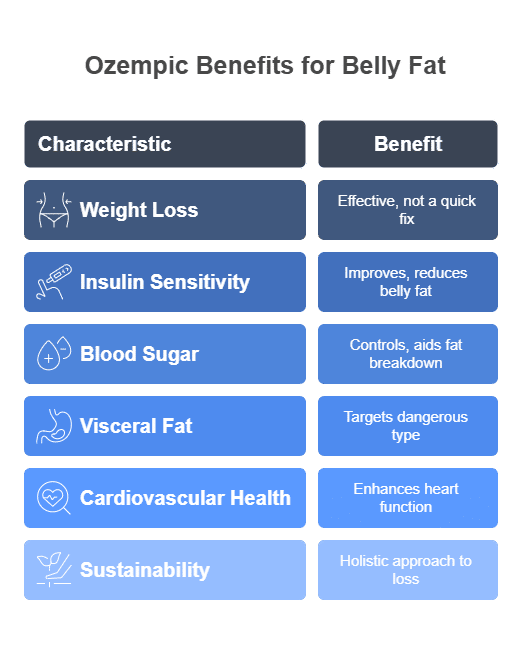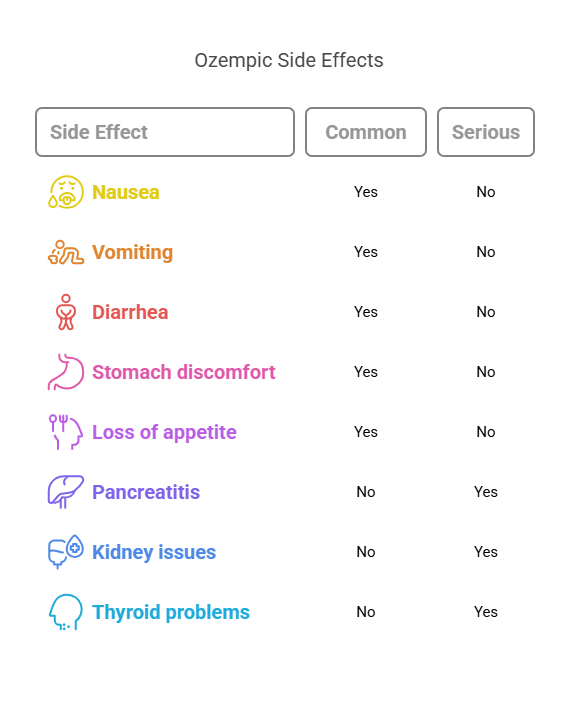How Ozempic helps reduce belly fat is a topic gaining attention as the medication shows promising potential in weight loss, especially when it comes to reducing belly fat. Originally prescribed for managing type 2 diabetes, it’s now becoming a go-to option for those looking to shed pounds. So, what makes Ozempic stand out? It contains semaglutide, an active ingredient that helps control appetite, improve insulin sensitivity, and regulate glucose factors that play a major role in fat storage, particularly around the belly.
Belly fat isn’t just an aesthetic concern. It’s often linked to serious health problems like heart disease, diabetes, and high blood pressure. That’s why losing excess belly fat can have a huge impact on your overall health. Many people struggle with stubborn belly fat despite diet and exercise, and this is where Ozempic comes into play.
In this article, we’ll explore how Ozempic works to reduce belly fat, the science behind it, and who can benefit from this treatment. So, let’s dive in and break down how Ozempic can help you target that stubborn belly fat.
The Connection Between Ozempic and Belly Fat Reduction

Belly fat is more than just a cosmetic concern it’s a health risk. There are two types of fat in the belly area: visceral fat and subcutaneous fat. Visceral fat is the dangerous kind, stored deep inside, surrounding vital organs like the liver and heart. This type of fat is linked to serious conditions such as heart disease, type 2 diabetes, and high blood pressure. Subcutaneous fat, on the other hand, is the layer of fat just beneath the skin, which is less dangerous but still contributes to weight gain and body discomfort.
Excess belly fat, especially visceral fat, has been shown to increase the risk of metabolic syndrome, a group of conditions that can lead to heart disease, stroke, and diabetes. Carrying too much fat around the middle can make it harder for your body to manage blood sugar, leading to insulin resistance, and raise levels of harmful cholesterol, all of which can affect long-term health.
Now, let’s talk about how Ozempic targets belly fat. Ozempic works by improving insulin sensitivity and reducing appetite, which are both key to tackling belly fat. Better insulin management means your body is more efficient at processing glucose and less likely to store fat, particularly around the belly. Additionally, the reduced appetite makes it easier to cut back on calorie intake, which helps with overall weight loss. Over time, this combination can specifically target the fat around your abdomen.
There’s clinical evidence backing up the effectiveness of Ozempic in reducing belly fat. Studies have shown that people using Ozempic experience noticeable weight loss, particularly in the abdominal area. In one study, participants lost a significant amount of visceral fat after using Ozempic for several months. While results may vary from person to person, the evidence suggests that Ozempic can be a powerful tool in reducing stubborn belly fat.
Benefits of Using Ozempic for Belly Fat Reduction

Losing belly fat can be tough, even with diet and exercise. Ozempic, a medication originally used for type 2 diabetes, has become popular for helping reduce belly fat. It works by controlling appetite, improving insulin sensitivity, and regulating blood sugar. These factors make it easier to shed fat, especially around the belly. In this section, we’ll explore how Ozempic helps target belly fat and why it’s effective.
Effective Weight Loss: Not Just a Quick Fix
Ozempic has been proven to help people lose weight gradually, especially in stubborn areas like the belly. Unlike some quick-weight loss solutions, Ozempic works by addressing the underlying factors of weight gain: appetite control, insulin regulation, and fat storage. By improving appetite control, users are able to reduce their caloric intake more naturally, making weight loss a sustainable process. Clinical trials have shown that participants experienced significant weight loss, particularly in abdominal fat, over a period of several months.
Improving Insulin Sensitivity: A Key to Reducing Belly Fat
Insulin plays a huge role in fat storage, especially around the belly. When the body becomes insulin resistant, it leads to excess fat buildup in the abdominal area. Ozempic works by improving the body’s sensitivity to insulin, helping it process glucose more effectively. This prevents excess glucose from being stored as fat, reducing the chances of belly fat accumulation. By addressing insulin resistance, Ozempic helps to reduce the root cause of stubborn belly fat in many people.
Blood Sugar Control and Fat Breakdown
Beyond just insulin sensitivity, Ozempic also helps with blood sugar control, which is important for overall metabolic health. Stable blood sugar levels mean fewer insulin spikes and less fat storage. The combination of reduced glucose fluctuations and improved insulin regulation creates an environment where the body is more likely to use stored fat for energy rather than storing more fat. This helps break down fat, particularly in the belly area, leading to overall weight loss and a healthier body composition.
Targeting Visceral Fat: The Most Dangerous Type
Visceral fat, the type of fat that wraps around internal organs, is a major contributor to heart disease, diabetes, and other serious health conditions. Ozempic specifically helps target and reduce visceral fat, which is often the most stubborn to lose. This type of fat is more metabolically active and releases harmful substances into the bloodstream that can increase inflammation and insulin resistance. By helping to reduce visceral fat, Ozempic not only helps slim down the belly but also reduces the risk of chronic diseases linked to excess abdominal fat.
Enhanced Cardiovascular Health
One of the overlooked benefits of Ozempic in reducing belly fat is its potential impact on cardiovascular health. As belly fat decreases, so do the risk factors associated with heart disease, such as high blood pressure, elevated cholesterol, and triglycerides. Ozempic’s effects on reducing visceral fat and improving insulin sensitivity can lead to better heart health, making it an attractive option for those who are at risk of cardiovascular disease.
Long-Term Sustainability: A Holistic Approach to Weight Loss
Ozempic isn’t a short-term fix; it encourages long-term, sustainable weight loss. The way it helps control appetite and balance insulin levels makes it easier for people to maintain healthier habits. When combined with a balanced diet and regular physical activity, Ozempic’s effects can last well beyond the treatment period, making it easier to keep off the weight and maintain healthier body composition in the long run.
Potential Side Effects of Ozempic
While Ozempic is effective for weight loss and belly fat reduction, it may come with some side effects. Here are a few to keep in mind:

- Common Side Effects:
- Nausea
- Vomiting
- Diarrhea
- Stomach discomfort
- Loss of appetite
- Serious Side Effects (less common):
- Pancreatitis (inflammation of the pancreas)
- Kidney issues (changes in urination or swelling in the legs/ankles)
- Thyroid problems (a lump or swelling in the neck)
- What to Do:
- If you experience severe abdominal pain, nausea, or changes in urination, contact your healthcare provider immediately.
- Ozempic may not be suitable for individuals with certain medical conditions, so a consultation with a doctor is essential before starting the treatment.
How to Incorporate Ozempic into Your Weight Loss Journey
Ozempic can be a powerful tool in your weight loss journey, but it works best when combined with healthy lifestyle changes. Here’s how you can make the most of it:

- Stick to a Balanced Diet: Ozempic helps control appetite, but eating a balanced, nutrient-rich diet is key. Focus on whole foods, lean proteins, vegetables, and healthy fats to support your body’s needs.
- Exercise Regularly: While Ozempic helps reduce fat, adding regular physical activity like walking, strength training, or yoga can speed up weight loss and improve overall health.
- Monitor Your Progress: Track your weight, diet, and any side effects. Regular check-ins with your doctor will help ensure you’re on the right path and adjust your treatment if needed.
- Sustain Long-Term Habits: Ozempic isn’t a quick fix. For long-term success, make lifestyle changes that you can maintain, like better eating habits and consistent exercise. This combination will help you keep the weight off even after you stop using Ozempic.
Conclusion
Ozempic has proven to be an effective option for reducing stubborn belly fat, especially for individuals with obesity, type 2 diabetes, or insulin resistance. By controlling appetite, improving insulin sensitivity, and regulating blood sugar, it addresses the key factors behind belly fat accumulation. With the right combination of lifestyle changes and medical guidance, Ozempic can help you achieve lasting weight loss and improve your overall health.
However, it’s important to remember that Ozempic is not a one-size-fits-all solution. Before starting, make sure to consult your healthcare provider to determine if it’s the right choice for you. With careful planning, consistency, and support, you can target belly fat effectively and take control of your health in a sustainable way.








